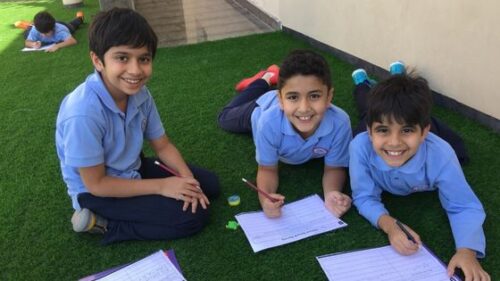Collaborative learning is an educational approach that puts the onus on students to assume active roles in their learning and “do the work” themselves. Collaborative learning strategies present individuals with an opportunity to benefit from shared accountability, as well as the knowledge and strengths demonstrated by others.
Teaching in the 21st century requires educators to extend beyond subject matter and help students fine-tune skills for life, literacy, and learning. Learning skills (often referred to as The Four Cs) include critical thinking, creativity, collaboration, and communication. It can be argued that fostering a collaborative learning environment addresses each of the learning skills and prepares students for cooperation outside of the confines of the classroom as contributing members of society.
What does collaboration in the ELL classroom look like?
Collaborative learning in the ESL/EFL classroom varies widely but always presents as learner-centered. As an educational approach, collaborative learning shifts responsibility from teacher to student, asking them to work with their peers to learn something new together. This active learning approach allows students to explore a topic and construct meaning amongst themselves, with the teacher acting as a facilitator throughout the process.
Cooperative learning in the EFL classroom serves multiple purposes in that the social exchange that takes place is equally as important as the content under study. Interpersonal skills develop as the students collaborate to explore content, work through a challenge, or apply previously-taught course material in a novel context.
How does collaboration help ELL students?
Wondering, “How can peers help ELL students?” There is ample research that suggests that students benefit significantly from collaborating with their peers.
Vygotsky’s Sociocultural Theory
In his Sociocultural Theory (1978), Lev Vygotsky posited that learning is social in nature. He argued that learning from others (known as other-regulation) helps learners progress to autonomous learning (self-regulation). Exposure to peers’ language development provides students with input that is varied, ultimately leading to greater language comprehension and knowledge. Peer feedback, even if indirect, is critical for language development.
In this same vein, Vygotsky maintains that students benefit from working with more-skilled peers in what he refers to as the Zone of Proximal Development (1978). The Zone of Proximal Development (ZPD) illustrates the gap between what an individual is able to achieve when learning autonomously, and what an individual can achieve with assistance from more advanced individuals. Social interaction stimulates growth, and strategic pairing on the part of the teacher bolsters cognitive – and language! – development.
Check out the following video to learn more:
Krashen’s Affective Filter Hypothesis
Another prominent figure in constructivism and language acquisition is Stephen Krashen. In his Affective Filter Hypothesis, a pillar of his Monitor Model (1985), Krashen explored how students’ attitudes and emotional responses play a role in either facilitating or hindering language acquisition. If teachers want to augment the efficacy of instruction, they need to consider their learners’ affective filters, ultimately working to decrease them, and “open students up” for learning. Affective filters dictate the anxiety, motivation, self-confidence, and personality traits in individuals, so it would be remiss to ignore this part of the human experience. Teachers need to consider Social and Emotional Learning (SEL) and rapport-building strategies to make students feel comfortable in the learning environment, getting them ready to learn from and engage with their peers in meaningful collaboration.
Watch this video for more information:
What are some general guidelines for creating a collaborative learning environment?
While it’s relatively easy to think of ways for students to collaborate, the execution requires more careful attention and planning. Before unpacking some easy-to-implement collaborative learning strategies, consider the following guidelines and how they might fit into your context.
Teach Students to Be Team Players
Whether you work with children, teenagers, or adults, you can’t make the assumption that your students play well with others. You might be working in a cultural context that places a higher value on individualism and personal achievement than on collaboration with others, so you need to be aware of the distinct needs that might be present in your classroom.
When fostering a collaborative learning environment, lead with the concept of accountability. Students need to learn how to hold themselves accountable for their participation and output first and foremost. Only once they have an understanding of individual responsibility and contribution to a team can they effectively collaborate with peers. Developing a sense of self-accountability transfers into holding others accountable for their contributions as well – this is where the team-support dynamic becomes apparent. Students need to learn calm and kind communication for these exchanges, too. With collaboration comes conflict, and students need to be equipped with tools to work through conflict in a compassionate way.
Create Structure (and Scaffolding) That Supports Collaboration
In alignment with Vygotsky’s theory that students learn from more competent or proficient peers when asked to rise to the occasion, creating tasks for students that are complex in nature can have the same effect, essentially forcing students to “need” their peers to be successful. Johnson, Johnson, and Holubec (2008) encourage teachers to consider complexity as a means of fostering “positive interdependence,” the belief that the success of the individual is dependent on the success of the group.
One of the greatest challenges teachers face in facilitating collaborative learning is their own inability to let go and trust the process. As long as the activity has been designed in an intentional way, the opportunity for the gradual release of control exists, shifting responsibility away from the teacher to the learner. Of course, you should maintain involvement and step in when necessary, but ideally, collaboration happens without your input. Your task design allows for student autonomy and interdependence.
You can use Bloom’s taxonomy (a categorization of lower- and higher-order thinking skills) when applying scaffolding. Learn more by reading this article or watching a BridgeUniverse Expert Series webinar on the topic (below is a short clip from the webinar).
Be Strategic in the Creation of Groups
When designing collaborative learning activities, there is a need to consider more than simply task design and activity structure. Consider the individuals’ unique qualities and how students’ strengths can be harnessed through collaboration. What areas for improvement do you notice, and how can you pair students in a way that addresses those sticking points? Strategic pairing is a necessary part of collaborative learning design.
It’s also crucial to consider group dynamics in terms of personalities and context-specific behavior. Limit the opportunity for certain individuals to carry the weight of their peers. To ensure that there are no “free rides” in collaborative learning, consider assigning roles to team members, spreading the responsibility equitably. (Notice the emphasis on equity over equality there – capitalize on students’ strengths over deficits, and be realistic when you create team expectations.)
Explore what it’s like to teach English to groups online.
Build In Ample Opportunity for Discussion
Now that you’ve provided students with language and strategies for resolving conflict in a gentle manner, make sure that there is time to allow for natural discussion and debate to unfold in the process. All students deserve to have their voices heard, and collaboration lends itself to that, with its focus on student-generated output. Give the students a chance to get to know one another as they work through the task, allowing disagreements to surface organically. Create space for authentic expression and group decision-making.
What are some collaborative learning strategies?
Now that the foundation for collaboration in the ESOL/EFL classroom has been constructed, it’s time to get into specific collaborative learning strategies! The following activities are highly adaptable to suit the needs of your learning context and pupils.
Strategy #1: Think/Write-Pair-Share
Think-Pair-Share or Write-Pair-Share is considered a classic collaborative learning strategy. In either format, students spend time alone with their thoughts, working through a question or problem independently. After students have concretized their own thoughts (by formulating an answer or potential solution, depending on the prompt), they chat with a peer and share their ideas. Students, no matter their proficiency in the language, automatically feel more comfortable in the exchanging of ideas with their peers, as they’ve had a chance to reflect quietly and prepare for the encounter. After students participate in a conversation with their partners, pairs are asked to share their insights with the whole group. You could ask students to report on what they told their partners, what their partners shared, or even the main takeaways from their respective conversations.

Strategy #2: Peer Review
Take your strategic pairing to the next level by engaging students in peer review activities. One of the advantages of collaborative learning is that it reminds students that their peers are an incredible wealth of knowledge; they are resources that can aid in their learning. It’s not only teachers’ feedback that helps students improve. Whether students are working on revising a composition, preparing talking points for a presentation, or even something with much lower stakes, students can use each other in the review process. Peer review processes require a certain amount of front-loading to ensure students know how to engage and offer feedback to one another, but this is extremely feasible with scaffolding. Model effective feedback strategies and language before asking students to dive in, so you maintain standards for respect and shared accountability in the learning environment.
Strategy #3: Jigsaw Technique
Jigsaw is a collaborative learning strategy that comprises self- and other-accountability simultaneously. In a traditional jigsaw, students are divided into small groups and assigned a “piece of the puzzle.” In their small groups, they work to find a solution and report their developments to the whole class. To amp up this activity, create roles within each small group, requiring each individual to become an “expert” in a particular area. Not only will students feel proud when you refer to them as experts, but they’ll hold themselves to a higher standard in the process. Pair this activity with a Gallery Walk, where students move about the room and engage with representatives from different groups. Not only will students get more time to chat with one another, but they’ll be able to notice the big picture that is the culminating project or task, as well as the learning community that they are a part of.
Working with professional students? Learn how to incorporate 21st-century skills into the Business English classroom to prepare your pupils for long-term success!
Strategy #4: Group Problem-Solving
Examining case studies can be an effective collaborative strategy because it requires students to analyze a scenario and attempt to understand different elements at play – whether cultural, communicative, or perhaps a combination of both – that led to a specifc outcome. Examine a less-than-ideal outcome and ask students to work together to propose solutions. With distinct life experiences and perspectives, students might be challenged to reach a consensus. Group problem-solving activities develop critical thinking, conflict resolution, and communication skills that will serve students for years to come.
Creating a collaborative learning environment requires some thoughtful consideration and a strong foundation, but it doesn’t have to be complicated. Collaborative learning strategies in ELL are especially fruitful when implemented regularly as a part of a routine, allowing students to become more comfortable with collaboration over time and to accept it as a non-negotiable in the learning process. By incorporating collaborative learning strategies into your English language lessons, you are giving your students a distinct advantage in their lives outside of the classroom.













